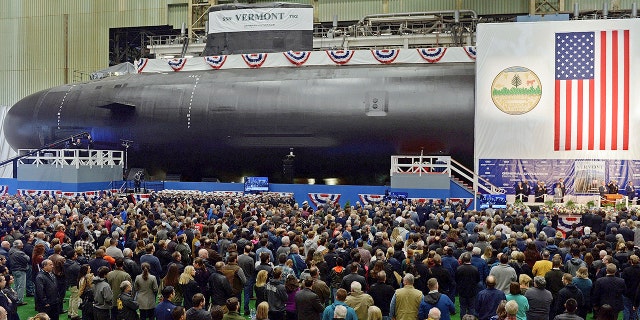Saturday, November 13
Falsifying Navy Steel Results
Elaine Marie Thomas, 67, of Auburn, Washington, was the director of metallurgy at a foundry in Tacoma that supplied steel castings used by Navy contractors Electric Boat and Newport News Shipbuilding to make submarine hulls.
From 1985 through 2017, Thomas falsified the results of strength and toughness tests for at least 240 productions of steel — about half the steel the foundry produced for the Navy, according to her plea agreement, filed Monday in U.S. District Court in Tacoma. The tests were intended to show that the steel would not fail in a collision or in certain "wartime scenarios," the Justice Department said.

The United States Navy's nuclear-powered attack submarine USS Vermont is christenedat Electric Boat in Groton, Conn. in October 2018. (Sean D. Elliot/The Day via AP, File)
There was no allegation that any submarine hulls failed, but authorities said the Navy had incurred increased costs and maintenance to ensure they remain seaworthy. The government did not disclose which subs were affected.
Thomas faces up to 10 years in prison and a $1 million fine when she is sentenced in February. However, the Justice Department said it would recommend a prison term at the low end of whatever the court determines is the standard sentencing range in her case.
In a statement filed in U.S. District Court on her behalf Monday, her attorney, John Carpenter, said Thomas "took shortcuts."
"Ms. Thomas never intended to compromise the integrity of any material and is gratified that the government’s testing does not suggest that the structural integrity of any submarine was in fact compromised," Carpenter wrote. "This offense is unique in that it was neither motivated by greed nor any desire for personal enrichment. She regrets that she failed to follow her moral compass – admitting to false statements is hardly how she envisioned living out her retirement years."
Thomas' conduct came to light in 2017, when a metallurgist being groomed to replace her noticed suspicious test results and alerted their company, Kansas City-based Bradken Inc., which acquired the foundry in 2008.
Bradken fired Thomas and initially disclosed its findings to the Navy, but then wrongfully suggested that the discrepancies were not the result of fraud. That hindered the Navy’s investigation into the scope of the problem as well as its efforts to remediate the risks to its sailors, prosecutors said. READ MORE...
We Need Mythologies
The primary villain of this story was Plato, whom Nietzsche accused of setting philosophy on its rationalist track. Plato’s immortalisation of his teacher, Socrates, amounted to nothing less than a morbid obsession with intellectual martyrdom. His Theory of the Forms taught generations of philosophers to seek truth in metaphysical abstractions, while devaluing lived experiences in the physical world. Plato’s intellectual revolution, in particular, was born out of the destruction of myth. In his wake, philosophy had been left ‘stripped of myth’ and starved of cultural roots. Modern culture, for Nietzsche, continued to languish in the shadow of Plato’s legacy, still grappling with its ‘loss of myth, the loss of a mythical home, a mythical, maternal womb’.
Seven decades later, at the end of the Second World War, Karl Popper mounted what would become, after Nietzsche, the second-most famous attack on Plato in modern philosophy. In The Open Society and Its Enemies (1945), Popper suggested that Plato had provided Western thought with its first blueprint of the ‘closed society’. In the Republic, Plato envisioned an ideal city that prioritises the harmony of the collective over the freedom of individuals, the preservation of the status quo over innovation, and the authority of intellectual gatekeepers over democracy and truth. The toxic influence of Plato’s political vision, Popper argued, could be traced through the history of philosophy, all the way to Nazi Germany and other forms of contemporary totalitarianism.
Like Nietzsche, Popper blamed Plato for setting Western philosophy on the wrong course. He did so, however, for precisely the opposite reason. Popper’s Plato was no rationalist. Rather, Popper boiled down the difference between open and closed societies to the difference between a culture of criticism and a culture of myth. Plato, as the first and the greatest of the enemies of the open society, had advocated the suppression of free criticism in order to establish an ‘arrested state’, sustained by myths and deception. Pointing to the Republic’s controversial foundation narrative, the Myth of Metals, Popper credited Plato with writing an ‘exact counterpart’ to ‘the modern myth of Blood and Soil’.
Who was right? Was Plato a short-sighted rationalist, who led philosophy astray by unmooring it from a more authentic, mythic past? Or was he a devious mythmaker, who introduced an uneasy current of irrationalism into the citadel of reason? How could he be both? Put differently: was Plato to blame for steering philosophy away from myth, or for bringing it closer to myth?
Neither The Birth of Tragedy nor The Open Society is celebrated today for its author’s fidelity to historical accuracy. Nonetheless, both remain iconic because Nietzsche and Popper were each on to something resonant about the relationship between myth and philosophy, and the curious symbolic role of Plato in our inherited understandings of that relationship. READ MORE...
Friday, November 12
Ancient Hangover Prevention
Raw eggs and Bloody Marys may be among today's hangover cures, but archaeologists in Israel have discovered an altogether different solution from the past: A gold and purple amethyst ring.
Excavated in the city of Yavne, the ancient jewel was uncovered from the site of the Byzantine era's largest known winery, according to the Israel Antiquities Authority. In an accompanying press release, archaeologists Amir Golani said that amethyst may have been worn to prevent the ill-effects of drinking too much alcohol.
"Many virtues have been attached to this gem," he is quoted as saying, "including the prevention of the side effect of drinking, the hangover."

The ring as it was discovered during the excavation in Yavne, a city in central Israel. Credit: Eliahu Valdaman/Israel Antiquities Authority
The ring was found just 150 meters (492 feet) away from the remains of a warehouse containing amphorae, a type of jar used to store wine. The excavation site has been dated to approximately the 7th century -- around the end of the Byzantine era and the start of the Early Islamic period -- though officials said the ring could be even older.
"Gold rings inlaid with amethyst stone are known in the Roman world, and it is possible that the ring's find belongs to the elites who lived in the city as early as the 3rd century CE," the press release said.
Golani said that amethyst was believed to have many other "virtues" and has religious associations, having been mentioned in the Bible. He also speculated that the ring, which weighs 5.11 grams (less than 0.2 ounces), once belonged to an "affluent" person.
"The wearing of the jewel indicated their status and wealth," he added. "Such rings could be worn by both men and women." READ MORE...
Be More Confident
But there’s an effective solution: Swap out weak words and phrases for ones that will make you come across as more professional and capable.
Here’s what psychologists, linguists, recruiters and CEOs say you should avoid using if you want to get ahead, along with simple replacements that will make a big difference in how you are perceived:
What to say instead: “What are your thoughts?” or “I’d like your input on this.”
If you ask “Does that make any sense?” after you’ve finished sharing a thought, you’re immediately giving the impression that you’re not convinced yourself, that your idea might be incomplete.
Rather than seeking validation or approval, you should be asking the listener or reader for their opinions on your idea.
What to say instead: “Let’s try…” or “It’s a good idea to try…”
Up until the mid-19th century, “maybe” was written as two words — “may” and “be” — which makes it clear that it literally refers to something that might happen, but might not.
That’s pretty wishy-washy when you apply it to your own ideas or suggestions. Either you believe in what you’re talking about, or you don’t.
What to say instead: “I believe this would …”
This is a minor distinction, but a valid one: “I think” sounds weaker than “I believe,” and is a little more doubtful, as if you’re saying something might work, but you’re not sure.
“I believe” puts you in charge of the thought and conveys a calm surety. And even if you’re not so sure at all, no one needs to know that!
What to say instead: Whatever you were going to say after the “but”
You don’t need to add disclaimers. Similarly, if you start your sentence with “I know this might be a stupid question, but …” or “I don’t want to sound pushy, but …,” you’re undermining yourself.
It’s an easy rule that bears repeating: Don’t put yourself down. Ever.
What to say instead: “I wanted to touch base ...”
How many times have you started an email with “Just wanted to ask you if …”? The problem in this case is that the “just” is a softener — almost an apology, as if you’re saying, “I hate to bother you, but …”
There’s a time and a place for that, but business communication generally isn’t. READ MORE...
Inside a Cargo Ship
A merchant marine gave a tour of a 958-foot cargo ship in 2019 that showed the intricacies of hulking freighters that haul 90% of the world's goods.
In the video, second mate Bryan Boyle records the vast array of machinery that keeps the ship moving, as well as the crew's and officers' living quarters on the Maersk ship, which was built in 2006.

In the ship's voyage, it sets out from Norfolk, Virginia, making several stops in the US before heading toward Belgium, Germany, and the Netherlands, to name a few destinations.
"I've had the opportunity to work on some interesting vessels," Boyle told Insider. "I've gotten to go to places that the average person wouldn't even know about. It's one of the most appealing aspects of the job."
Boyle said that there's a thrill to arrive at new destinations, remembering how he spent over a month in Africa on one trip. But the amount of time that crews get to explore new destinations has dwindled over the years, he said, as ships rush to get in and out of ports as fast as possible and early COVID-19 restrictions set limits to crew excursions.
The video shows Boyle's living quarters, as well as a movie locker that holds hundreds of titles. READ MORE...
Thursday, November 11
Quantum Immortalilty Theory

The quirky, time-twisting, death-looping comedy series landed on Netflix back in 2019, and was so odd and out there that it was hard to firmly define its genre. It’s a comedy, yes, and clearly sci-fi – with inspiration from the world of game mechanics as well as quantum theory – but the wisecracking cocaine enthusiast found in lead character Nadia (played by Natasha Lyonne) means Russian Doll feels nothing like the likes of Star Trek.
However, the mind-bending show rests on some notable assumptions about the nature of the universe, or rather multiverse, and how our lives are tied up with it – and with a second season expected in the near future, it feels like a good time to revisit Russian Doll, and the scientific concepts underpinning it.
In Russian Doll, game developer Nadia Vulvokov finds herself in a classic Groundhog Day scenario – forced to repeat the same day over and over. Except, much like quantum mechanics breaking the mold of classical physics, Russian Doll gives this scenario a twist, killing off its main character again and again in various and very sudden ways – be they by car crashes, deep rivers, or deadly staircases – and always returning her to the same moment in her bathroom, looking at the mirror and realizing she has to relive her 36th birthday all over again. READ MORE...
Bill Gates' Nuclear Plants
 |
| Will smaller, modular reactors soon coexist with big ones like this here in Jenkinsville, South Carolina? |
Bill Gates' nuclear energy firm TerraPower and power company PacifiCorp — owned by Warren Buffett's holding company Berkshire Hathaway — teamed up in September 2020 to launch the Natrium project. It's about a small modular reactor they say will be commercially viable by 2030.
Many countries are weighing smaller, so-called modular, nuclear reactors as a way backing up low emission energy production during the transition from fossil fuel dependence to one based on renewable energy sources.
The reactor, to be built by Bechtel, will be in Wyoming, the United States top coal-producing state, Gates said. "We think Natrium will be a game-changer for the energy industry," he said.
The US Department of Energy has awarded TerraPower $80 million (€70 million) to develop its ideas.
TerraPower says the plant will cost $1 billion, including engineering, procurement and construction costs, and is expected to take seven years to build. In the US, the cost of building a conventional nuclear power plant is around $25 billion and can take far longer to build.
"Smaller, advanced reactors like those being developed under the funding from Bill Gates and others offer novel applications, approaches, and opportunities for one of the world’s largest sources of noncarbon emitting energy, nuclear energy," Brett Rampal, director of nuclear innovation at nonprofit Clean Air Task Force, told DW.
"They aren’t that small, this is 345 MW," Antony Froggatt, a research fellow at Chatham House, told DW. "While much smaller than existing reactors (1,000 MW), they are still large and may not be as modular as intended and this undermines the argument that they can be built in factories and then shipped out, which is how they are supposed to be cheaper," he warned.
But "the next generation of advanced reactors will make more efficient use of materials, be easier to site, and offer a great balance to increased reliance on renewables in the form of always available clean energy," Rampal insisted. "The Natrium concept also incorporates a thermal salt storage system which allows for the power plant to operate more flexibly and boost power output for portions of each day without having to make significant adjustments in the actual operation of the reactor," Rampal said. READ MORE...
China Builds Mockups of US Warships
China has massively upgraded its military in recent years, and its capability and intentions are increasingly concerning to the United States as tensions rise over the South China Sea, Taiwan and military supremacy in the Indo-Pacific.
The images captured by Colorado-based satellite imagery company Maxar Technologies dated Sunday show the outlines of a U.S. aircraft carrier and at least one destroyer sitting on a railway track.
Maxar identified the location as Ruoqiang, a Taklamakan Desert county in the northwestern Xinjiang region.
The independent U.S. Naval Institute said on its website that the mock-ups of U.S. ships were part of a new target range developed by the People's Liberation Army.
It wasn't clear from the images how many details had been included in the apparent targets, although USNI said it had identified features on the destroyer including its funnels and weapons systems.
Chinese Foreign Ministry spokesperson Wang Wenbin said at a daily briefing Monday that he had no information about the images, saying, “I’m not aware of the situation you mentioned."
China's massive military upgrade has emphasized countering the U.S. and other countries' naval forces.
That includes the development of land, sea and air-launched missiles to repel and possibly sink opposing vessels, expressed most emphatically by the land-based DF-21D ballistic missile known as the “carrier killer." READ MORE...
Wednesday, November 10
Attending College
My first year in college was in 1966 after graduating from Cairo American College (high school) in Cairo, Egypt, UAR and traveling through Europe for several weeks.
During my college years, I was exposed to both LIBERAL POINTS OF VIEW as well as CONSERVATIVE POINTS OF VIEW... and, at the time, I was the most liberal person that you could ever imagine.
My degree from college was English but I did not want to teach and my first job was Director of Product Efficacy for a microbiogical media manufacturer. My second job was Executive Director for the Alamance County Arts Council where I decided to enroll in an MBA program so I could better manage the organization.
My views changed from LIBERAL to CONSERVATIVE as a result of my graduate education.
BUT MORE IMPORTANTLY... my education taught me HOW TO THINK... rather than just letting myself be influenced by my personal opinions and feelings even if those personal feelings were inappropriate.
I see myself now as a CONSERVATIVE LIBERAL...
My personality however, is different from most of the general public and I do not think that most of the general public as a result. As a result of MBTI, my personality has been identified as INTJ...
An Architect (INTJ) is a person with the Introverted, Intuitive, Thinking, and Judging personality traits. These thoughtful tacticians love perfecting the details of life, applying creativity and rationality to everything they do. Their inner world is often a private, complex one.
My personality does not make me worse or better than you... just different... but, I can tell you this... and, you can accept or reject it... but learning how to think is the best thing that you could ever do for yourself.
- My parents should not tell me how to think
- My church should not tell me how to think
- My teachers should not tell me how to think
- My government should not tell me how to think
THINKING IS MY RESPONSIBILITY AND ONLY
MY RESPONSIBILITY...











